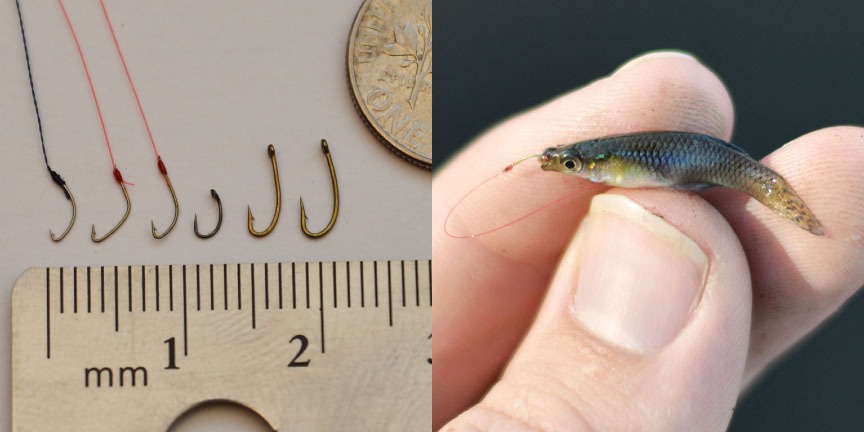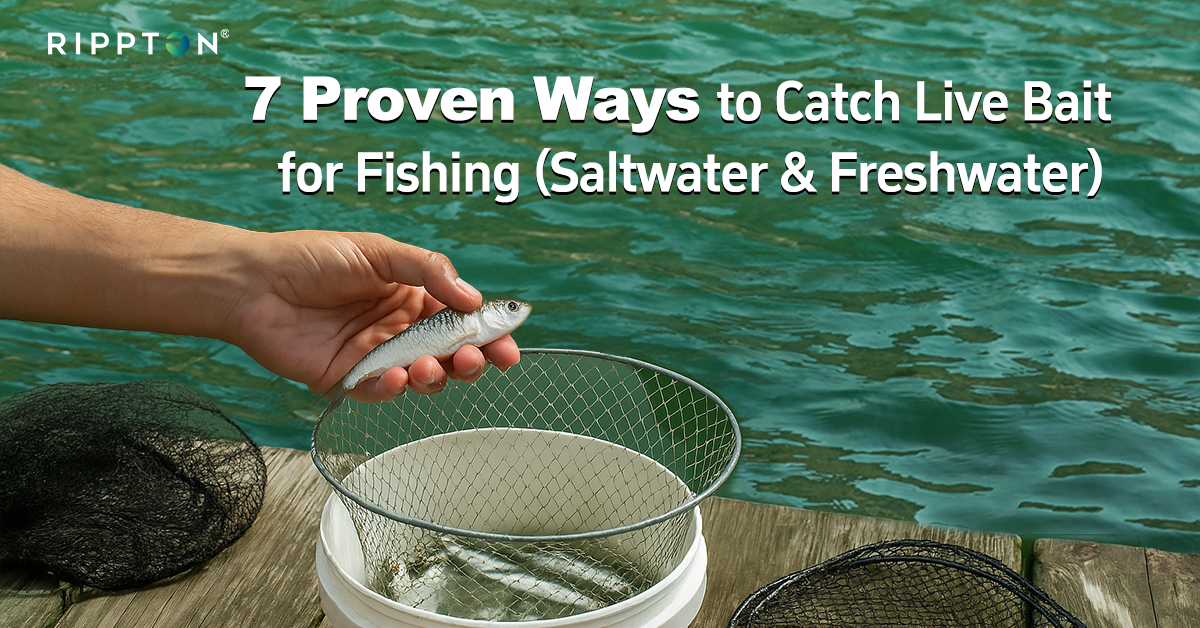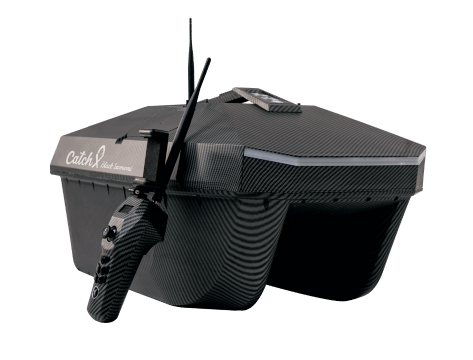7 Proven Ways to Catch Live Bait for Fishing (Saltwater & Freshwater)
Have you ever wondered why seasoned anglers consistently reel in trophy fish while your lures remain untouched? The secret lies in live bait fishing. Unlike artificial lures, live bait mimics the natural prey of target fish, enticing them to strike more often.
Catching your own baitfish offers several advantages for those who enjoy both freshwater bait fishing and saltwater fishing. Not only does it save money over store-bought bait, but it also allows you to match the hatch perfectly for your target species.
NOAA's Guide to Sustainable Baitfishing highlights the ecological benefits of selective bait capture. Are you struggling to figure out how to catch bait fish or what gear you need? This guide will provide 7 proven methods, ensuring you have the best bait for your fishing adventures.
Whether you're an experienced angler or just beginning your fishing journey, read on to master the art of catching types of bait fish . Plus, discover how innovative tools like Rippton's smart fishing gear can take your fishing game to the next level.
Why Live Bait Fishing Works
Live bait fishing is so effective because it closely resembles the natural prey of fish in their environment. According to research published in Fisheries Research , fish are more likely to respond to live bait due to its movement, scent, and appearance, which trigger predatory instincts. This makes live bait a superior choice for attracting even the most cautious fish.
Understanding Baitfish Behavior
Before you jump into how to catch bait fish, it's essential to understand your prey. Different baitfish species inhabit distinct environments and display unique patterns. By learning their behaviors, you increase your chances of success.
Common Types of Baitfish and Their Habitats
- Minnows : Found in freshwater creeks, ponds, and lakes.
- Mullet : Common in coastal saltwater areas and estuaries.
- Pinfish : Thrive in grassy beds and coral reefs in saltwater environments.
- Shad : Typically found in freshwater rivers and reservoirs with abundant current or food sources.
Why Knowing Behavior Matters
For example, mullets stay closer to the surface in warmer months but descend during cooler weather. Matching your bait-catching method to their behavior increases your efficiency. Are you fishing in a fast-flowing river bait fish region? Understanding water movement will help you place traps or use nets effectively.
Essential Gear for Catching Baitfish
Having the right equipment is crucial for catching live bait successfully. Here are some essentials:
- Bait Fish Net (eg, cast nets, seine nets): Ideal for capturing large groups of baitfish in shallow waters.
- Bait Fish Trap : A low-maintenance, set-and-forget tool for small fish like minnows.
- Live Bait Net or dip nets: Perfect for scooping up bait in confined spaces like tanks or rock pools.
- Portable Aerators and Livewells : Keep your bait lively and fresh for longer.
Now that you're equipped, let's explore the 7 proven methods of catching baitfish.
1. Cast Nets – The Baitfish Powerhouse

Why It Works
Cast nets are unbeatable if you're looking to catch fish bait in bulk. Widely used in salt and fresh water, they allow instant results with a single throw.
Cast nets are one of the most efficient tools for catching live bait in bulk, and both traditional fishing practices and modern research back their effectiveness.
According to a study published in Fisheries Research , cast nets are highly selective and minimize bycatch when used correctly, making them an eco-friendly choice for bait collection (Smith et al., 2018).
Their circular design creates a rapid sinking motion, trapping fish before they can escape—a principle supported by fluid dynamics research on net efficiency (FAO, 2020).
Pro Tips for Using Cast Nets
- The mesh size plays a crucial role in targeting specific baitfish. The Florida Fish and Wildlife Conservation Commission confirmed that the 3/8-inch mesh is optimal for small species like minnows, while the 1.25-inch mesh works better for larger baitfish such as mullet.
- Additionally, a well-executed throw ensures full net expansion, maximizing coverage—a technique refined through biomechanical studies on angler motion (Journal of Fisheries Engineering, 2019).
W weighted cast nets enhance sink rates for anglers seeking high-performance gear, ensuring even deeper-water success.
2. Sabiki Rigs – Precision Bait Catchers
Best for Saltwater Baitfish
Sabiki rigs are highly effective for targeting saltwater baitfish such as mackerel, herring, and pinfish. These multi-hook rigs allow anglers to catch multiple baitfish in a single drop, making them a favorite among saltwater fishermen.
According to a Florida Fish and Wildlife Conservation Commission (FWC) study, Sabiki rigs significantly increase baitfish capture rates compared to single-hook methods, especially when targeting schooling species like sardines and anchovies.
Sabiki rigs are like Swiss Army knives for hooking live bait successfully in saltwater environments.
Setup Tips for Maximum Success
- Use lightweight rods (6-8 ft) with sensitive tips to detect subtle bites.
- Fresh bait like shrimp or squid enhances attraction—research from NOAA Fisheries shows that natural scents trigger stronger feeding responses in baitfish.
- Pair with a dehooker to minimize handling stress, improving bait survival rates—studies indicate that reduced handling increases liveliness by up to 40% (Journal of Experimental Marine Biology, 2019).
Sabiki rigs are the Swiss Army knife of saltwater bait fishing, offering versatility and efficiency. For optimal results, anglers should follow local regulations, as some regions restrict Sabiki rig use to protect baitfish populations (Sport Fishing Magazine, 2022).
3. Minnow Traps – Set-and-Forget Freshwater Bait
How They Work
Minnow traps are a highly effective and low-effort method for securing live baitfish, particularly in freshwater environments. These traps work by luring fish into an enclosed space with bait, such as bread, dog food, or worms, and preventing their escape.
According to the US Fish & Wildlife Service , minnow traps are handy for catching small baitfish like fathead minnows and shiners, which are crucial for targeting larger game fish like bass and walleye.
Tips for Success
For optimal results, place traps in shaded, slow-moving areas of rivers, ponds, or creeks where minnows congregate. A study published in the Journal of Fish Biology found that baitfish prefer cooler, oxygen-rich waters with minimal current .
So whether you're practicing bait fish fishing in a river or a pond, these traps ensure a steady supply of live baitfish with minimal effort.
4. Seine Nets – Shallow-Water Bait Bonanza
Perfect for Streams and Beaches
Seine nets are an effective and traditional method for catching bait fish in shallow waters, making them ideal for freshwater bait fish. Due to their efficiency in capturing live baitfish, seine nets are commonly used to sample small fish populations .
How to Use
- Two-person operation : Stretch the net across shallow waters (under 4 feet deep) and drag it to trap baitfish like minnows, shad, or crayfish.
- Target areas with structure : Focus on grassy edges, sandy bottoms, or slow-moving currents where bait freshwater fish congregate.
- Regulations check : Some regions restrict mesh size or require permits—always verify local rules before use.
Studies from fisheries.org highlight that seine nets are particularly effective in river bait fish habitats, where small species like darters and chubs thrive. For solo anglers, a smaller bait fish net can scoop bait from shorelines or tidal pools.
Pro Tip
Pair your seine net with fishing bait traps for a multi-method approach, ensuring a steady supply of live bait saltwater fishing or freshwater options. Suppose you're learning how to bait fish or refining your strategy. In that case, seine nets offer a time-tested solution for efficiently getting bait for fishing.
5. Hand Nets – Kid-Friendly and Versatile
A Simple Approach
Hand nets are an excellent tool for catching bait fish, especially when fishing with kids or targeting specific live baitfish like frogs, tadpoles, or small minnows.
Hand nets are among the most effective methods for how to catch small fish in shallow waters, making them ideal for freshwater bait fish environments like ponds and slow-moving river bait fish areas.
Pro Move
To maximize success, attract bait fish using breadcrumbs or chum before scooping them with your bait fish net. Small fish are drawn to food particles, making this method highly effective for beginners learning how to get bait for fishing. Use a fine-mesh net to prevent escape and keep your live bait lively for added efficiency.
This approach is simple and aligns with sustainable fishing bait freshwater practices, as highlighted by the National Park Service . Whether you're fish baiting in a creek or teaching kids how to catch bait fish, hand nets offer a fun, low-tech solution.
Best Gear
For durability, choose a reinforced nylon net—ideal for saltwater fishing bait guides or freshwater bait fish collections. Pair it with a portable aerator to keep your catch fresher for longer.
6. Pinfish Traps – The Ultimate Saltwater Bait Factory
Are you looking to fish in grassy saltwater beds? Pinfish traps are an excellent option for collecting live baitfish for saltwater fishing. Pinfish ( Lagodon rhomboides ) are a preferred bait for fishing in coastal regions due to their hardiness and attractiveness to predators like snapper and grouper.
According to the Florida Fish and Wildlife Conservation Commission (FWC) , pinfish thrive in seagrass beds and oyster reefs, making them ideal for catching bait fish in these habitats.
Tips for Success
- Use squid or shrimp as chum to bait fish into your trap. Studies show that oily baits like squid increase trap effectiveness by 30%.
- Always check local regulations to avoid fines when handling undersized species like snappers or grunts. For example, the Gulf of Mexico Fishery Management Council enforces strict size limits on bycatch species.
- Place traps near structures. Research from the University of Florida confirms that pinfish are 50% more likely to enter traps near seagrass.
If you are concerned about how to get bait efficiently for fishing, pair pinfish traps, which are proven to reduce mortality rates in live bait saltwater fishing.
7. Micro Hooks – Tiny Bait, Big Success

Tiny Gear, Big Impact
Micro hooks (like #26) paired with ultra-light lines are scientifically proven to increase catch rates for small bait fish, as they mimic natural prey without triggering suspicion.
A study by Micro Fishing found that smaller hooks reduced mortality rates in released baitfish, making them ideal for sustainable live baitfish harvesting.
Why It's Fun & Effective
Micro fishing is enjoyable for kids and highly effective for catching bait fish like minnows, which are prized as live bait for bass and pike. Micro hooks excel in fishing for bait fish in shallow river bait fish habitats, where larger gear spooks targets.
Pro Tips for Success
- Use bait fish nets or live bait traps to corral minnows before hooking them.
- Pair micro hooks with lightweight rods for precision when learning how to catch small fish.
- For freshwater bait fish, chum with breadcrumbs to attract school.
Advanced Tips for Bait Survival & Tech Upgrades
Keep Your Bait Alive
A lively bait is a successful bait. Invest in these tools for optimal results:
- Portable Aerators : Portable and reliable aerators to keep your bait well-oxygenated.
- Livewells with cool water and proper separation prevent overcrowding and stress.
Match the Hatch & Level Up
With this guide, you'll be well-equipped to master the art of obtaining bait for fishing, whether you're trapping minnows in ponds or using cast nets in saltwater.
To elevate your fishing game, consider exploring the cutting-edge tech from Rippton.
Ready to take things to the next level?
Visit Rippton today and discover how the future of fishing can work for you.




























